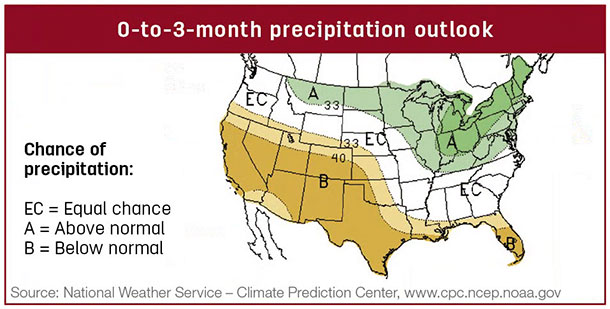However, if it continues to stay dry, there are some special supplementation considerations regarding vitamin A and, potentially, vitamin E that should be considered.
Some potential consequences of a vitamin A deficiency include reduced feed intake, low conception rates, abortions, stillbirths and abnormal semen production.
The vitamin A requirement for cattle is approximately 27.2 international units (IU) per pound of bodyweight for dry pregnant heifers or cows and 38.1 IU per pound of bodyweight for lactating cows. Thus, the requirement for a 1,300-pound dry pregnant cow would be 35,380 IU per day and 49,532 IU per day when the cow is lactating.
When supplies of vitamin A exceed requirements, cattle can store excess vitamin A in the liver for later use. However, from a practical standpoint, these stores are not likely to provide more than a two- to four-month supply.
Vitamin A requirements are generally met from green-growing forages and supplements that contain vitamin A. However, with the dry conditions, green-growing forages might be limited.
 Additionally, a fire at one manufacturing facility and some other manufacturing challenges have reduced the global supply of vitamin A. As a result, some feed manufacturers have reduced the amount of vitamin A or even eliminated it from their supplements.
Additionally, a fire at one manufacturing facility and some other manufacturing challenges have reduced the global supply of vitamin A. As a result, some feed manufacturers have reduced the amount of vitamin A or even eliminated it from their supplements.
If you don’t have green grass, make sure to check the supplements you feed will provide adequate levels of vitamin A.
For reference, if a loose mineral supplement contained 200,000 IU of vitamin A per pound, and consumption was 0.25 pound per day, it would provide 50,000 IU of vitamin per day. This would be enough to meet the daily needs of a 1,300-pound dry or lactating cow.
Vitamin A can also be supplied through injectable products. Many of these products also contain vitamins D and E. Vitamin A concentration and dosages will vary but, at the highest labeled dose rate, will result in providing either 1 million or 2 million IU of vitamin A per injection.
The products that supply 2 million IU would provide about a 56-day supply for a 1,300-pound dry cow – or 40 days if the cow is lactating. ![]()

-
Jason Banta
- Associate Professor and Extension Beef Cattle Specialist
- Texas A&M University
- Email Jason Banta








